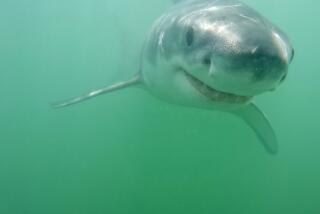Great White Hope
Under a thick layer of gray mist about five miles off the Ventura County coast, John OâSullivan is on the hunt for a great white shark.
But unlike the characters in the movie âJaws,â OâSullivan is not out to kill the oceanâs most feared predator.
In fact, his mission is quite the opposite: conservation.
OâSullivan, curator of field operations for the Monterey Bay Aquarium, is heading up a $1.2-million, three-year great white shark research project that began its second season Wednesday.
Researchers aim to answer basic questions on the lives of young white sharks -- 4-foot-long newborns that frequently get tangled in sport and commercial fishing gear during the summer months -- and hope to be the first to successfully capture a great white shark and exhibit it at a public aquarium.
Such an effort is important because, despite being considered fierce and invincible, great whites are actually fighting for survival, aquarium officials said.
A protected species in California waters, great white sharks are in steep decline worldwide, mainly because they are slow to reproduce and their fearsome reputation makes them a target for trophy hunters.
âIt deserves some recognition that this is not just a beast, but a beautiful animal that needs to be protected too,â OâSullivan said.
Although public aquariums have tried for decades to exhibit great whites in their tanks, none have been able to keep one alive for more than 21 days. In most cases, OâSullivan said, itâs because the sharks will not feed while in captivity.
Biologists attribute this to the âstress of capture,â saying most sharks are brought to aquariums by fishermen who inadvertently catch them.
Fixing this problem is the central goal of the Monterey Bay project.
Using four fishing vessels and a 5-million-gallon undersea mesh pen, a team of eight marine biologists and other experts will spend a month in the waters off the Ventura County coast.
Trolling with mackerel-laced hooks, they will attempt to catch baby great white sharks and tag them with electronic monitors. The data tags, which eventually pop off and float to the surface, can record a sharkâs movements, diving depths and the water temperatures it prefers. Information is fed back to scientists via satellite.
Some sharks that are caught will be tagged and released, but great white sharks in good condition could be transferred to the underwater pen, where scientists may observe their behaviors and attempt to feed them.
A series of steps would then need to be undertaken -- including a simulated drive to Monterey -- before the research team would consider moving any great white into the aquariumâs 1-million-gallon âOuter Bayâ exhibit.
âWe need to have a lot of confidence that these animals can survive in an aquarium,â OâSullivan said. âWeâre not there yet.â
Great white sharks, which have been around more than 400 million years, average 15 feet in length at maturity and weigh more than 2 tons.
As a predator, the great white is at the top of the food chain, tearing its prey -- mostly sea lions, otters and sea turtles -- with its 3-inch-long, razor-sharp teeth.
Great white sharks also have a well-documented history of mauling humans, though scientists believe sharks attack people only when they mistake them for sea lions. They insist that great whites are not the blood-thirsty killers portrayed in the famous book and movie.
In the last 400 years, there have been 348 documented shark attacks, 67 of them fatal, said Christina J. Slager, a curator at the Monterey aquarium and a former staff member at San Franciscoâs Steinhart Aquarium when it briefly held a great white.
âThese sharks really do get a bad name,â Slager said. She said pollution, over-fishing and other human factors have added to the white sharkâs decline. âIn truth, they have more to fear from us than we do them.â
Despite wide public interest in great white sharks, scientists say little is known about their lifestyles.
The Monterey Bay Aquarium study could help answer questions on how many sharks are giving birth in the Southern California region, what young sharks eat, where they travel and how long they stay.
On the first day of this yearâs endeavor, only one shark -- a mako -- was hooked on the fishing line, tagged and released. The pen remained empty, watched by an observer boat, about 30 miles down shore.
âWeâve got the perfect-sized animal but the wrong species,â said OâSullivan, standing on the bobbing vessel and wearing a bright-yellow vinyl apron.
Last year, choppy and cold water conditions prevented the research team from finding any great white sharks, though a commercial fisherman caught one accidentally a few months later and tagged the shark before releasing it.
Randall Kochevar, science communication manager for the aquarium, conceded that the chances of the team taking a white shark back this year were slim to none. The project could extend into 2005, he said.
But those odds wonât stop the team from trying to give the 1.8 million visitors who come to the Monterey Bay Aquarium every year the unique experience of seeing a majestic great white up close.
âIf we can put those visitors face to face with a great white shark,â Kochevar said, âitâs going to go a long way toward changing the image they have in their minds from âJaws.â â
More to Read
Sign up for Essential California
The most important California stories and recommendations in your inbox every morning.
You may occasionally receive promotional content from the Los Angeles Times.










